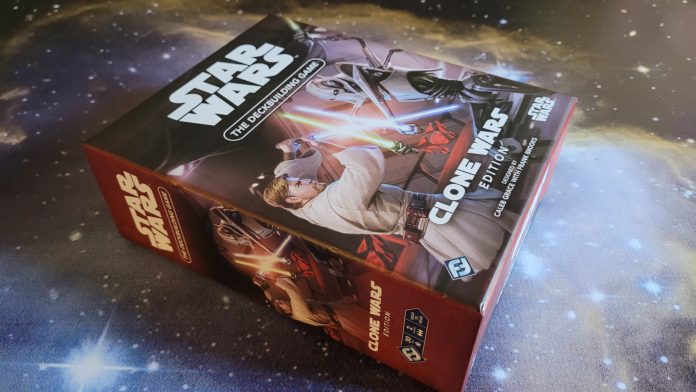Deck building games have been an extremely popular sub-genre of card game ever since the wildly successful Dominion first introduced the concept in 2008. It’s an easy format to plug just about any setting or I. P. into, and over the years there have been deck building games covering every imaginable theme, from dinosaurs (Apex Theropod Deck Building Game) to superheroes (Legendary, DC Comics Deck-Building Game). At this point the deck building mechanic is so well recognized that it has become viable to combine it with other board game elements in games like Dune Imperium and Undaunted. So it’s a little surprising that it has taken this long for a Star Wars deck building game to come out.
You get a lot of the same strategy, customizability, and game play that you would from a trading card game, but without the collectible chasing, lengthy prep time, and need to be familiar with ever-increasing pools of cards.
The Clone Wars Edition is the second installment of Fantasy Flight Games’ Star Wars: The Deckbuilding Game line. It’s a two-player stand-alone game that features content from Star Wars episodes I-III and the Clone Wars television series.
Begun, the Clone War Has
Players begin by choosing who will play as the Republic and who will play as the Separatists. Over the course of the game, players will take turns playing cards that generate one or more of the game’s three currencies: Resources, used to purchase new cards from the central play area called the Galaxy row; Attack, used to deal damage to the opponent’s base and also to remove their cards from the Galaxy row; and Force, used to move the Balance of the Force (more on that later).
As with most deck building games, each player starts the game with a basic deck of 10 cards. The starting decks are thematically different (clone troopers for the Republic player, battle droids for the Separatists) but functionally the same, with seven cards that generate 1 resource, two that provide attack strength, and one that allows the player to choose to generate one of either Attack, Resource, or Force, depending on what is needed at that moment.
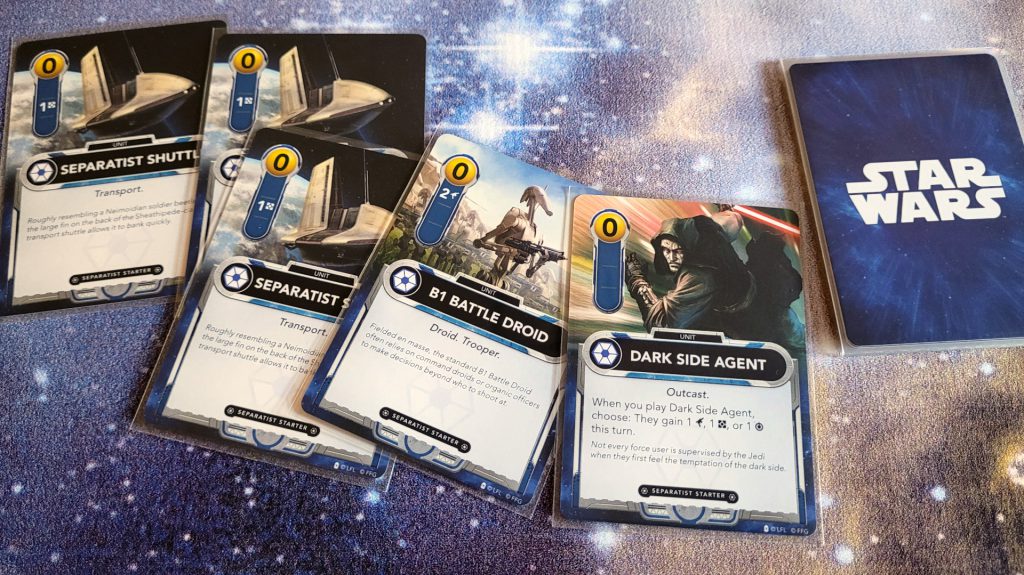
Each player also begins with a stack of 10 Base cards, representing planets from the Clone Wars saga. Destroying your opponent’s bases is how you win the game, with a standard game ending after one player has destroyed four bases. The first base played by each side is always the same, but after that players get to choose their next one. Each base has different strengths and weaknesses, making choosing a base one of the key decisions in the game.
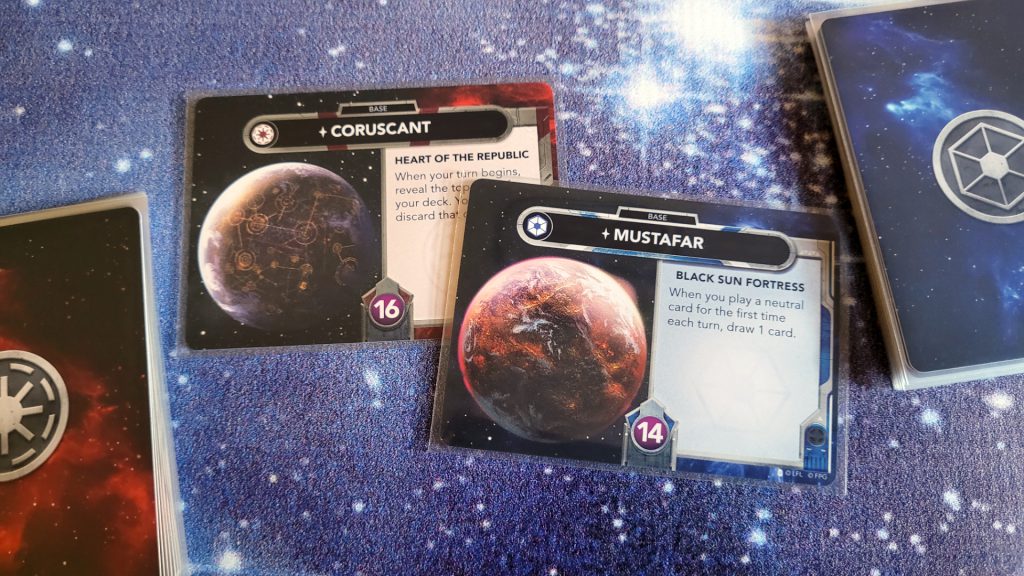
He Is the Chosen One. He Will Bring Balance…
The final game element is the Balance of the Force track, a small board that sits between the two players with seven spaces and a marker. The marker will move in one direction or the other depending on various game effects, most often by playing a character who provides Force. When the marker is closer to one player’s end of the track, the “Force is with” that player, a game state required by a few card effects. If it’s all the way at one player’s end at the start of their turn , that player gains an additional resource for that turn.
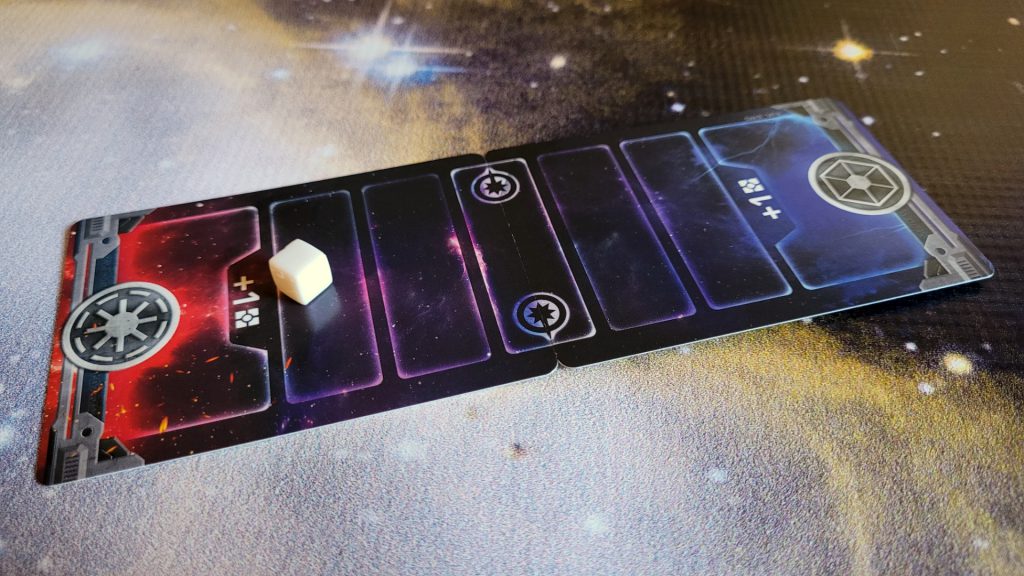
Here’s Where the Fun Begins
As the game progresses, players will alternate turns, playing cards to either interact with the Galaxy row or attack their opponent’s base.
The Galaxy row consists of five cards drawn from the game’s main 90 card deck, with cards representing both Separatist and Republic characters and starships, along with neutral characters representing the seedy side of the Star Wars universe. Additionally, there is a separate stack of Outer Rim Pilots, a 2-cost, 2-resource card that is always available for either player to purchase.
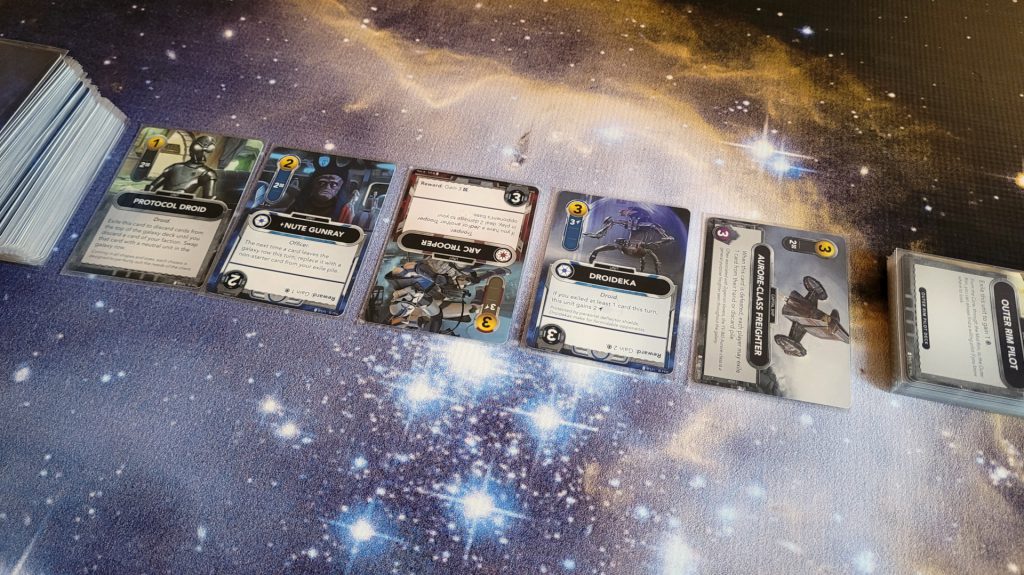
A player can only purchase cards from their own faction, or neutral cards – it wouldn’t do for Obi-Wan to suddenly start working with Count Dooku, after all. However, players can interact with cards from their opponent’s faction in the Galaxy row by engaging in bounty hunting and sabotage (two different names for the same type of action). Each Separatist and Republic card (other than the capital starships) has a target value and a reward printed upside down on the bottom of the card. If a player spends attack equal to the card’s target value, the card is discarded and that player gains the reward.
It’s an interesting game element that gives players tactical decisions to make, with rewards that will often give you that one resource you need to buy an expensive card, or move the Balance of the Force in your favor when you really need it.
You don’t want to get too distracted with attacking your opponent’s cards in the Galaxy row though, as attacking their bases is how you win the game. Players can defend their bases by buying and playing capital starships, which must be destroyed before a base can be attacked. Unlike other cards, capital ships stay in play from turn to turn, providing resources or attack strength every turn while they are in play. But eventually they fall, leaving the base open to attack. Once a base has taken damage equal to its hit point value, it is destroyed. The player chooses a new base from their stack at the beginning of their following turn, unless it was their fourth base, in which case the game is over.
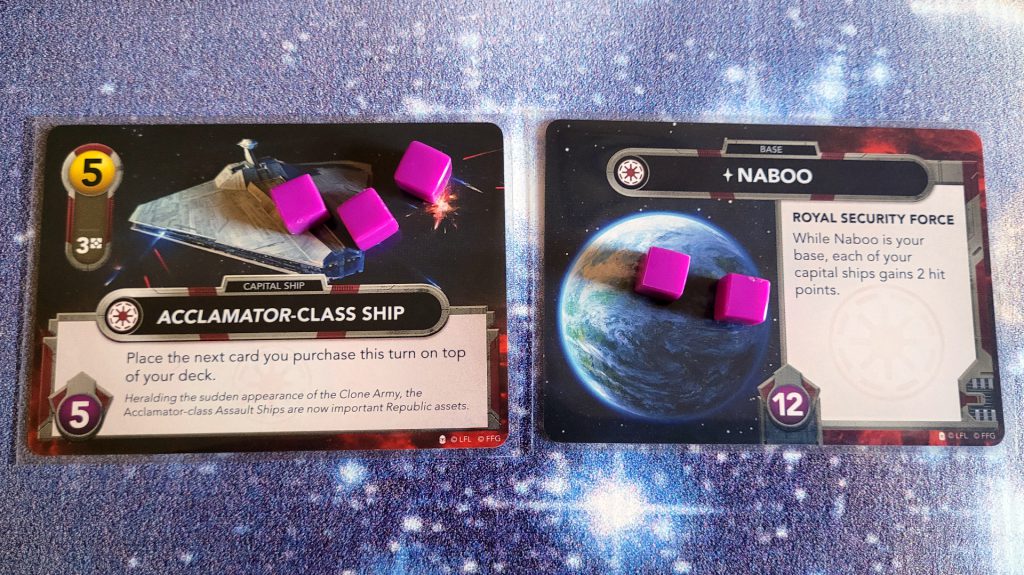
Faction Strategies and Synergies
The cards in the Galaxy deck are focused on specific game effects that are very much in keeping with the themes of the Clone Wars characters and stories.
The Separatists are an industrial complex with factories churning out millions of disposable droids, so their cards tend to focus on sacrificing units to an exiled pile (separate from the discard pile) to gain various game effects, and then playing cards from that pile, often at a reduced cost.

The Republic cards are split into two broad groups: clone troopers and Jedi Knights. The clones work better the more of them you have in play, keeping with the themes of loyalty and brotherhood that we see in the Clone Wars television series. The Jedi use their connection to the Force to manipulate the Republic player’s deck, with game effects that revolve around revealing, discarding or drawing the top card of the deck. They also present the easiest way to move the Balance of the Force marker, as all of them generate Force.
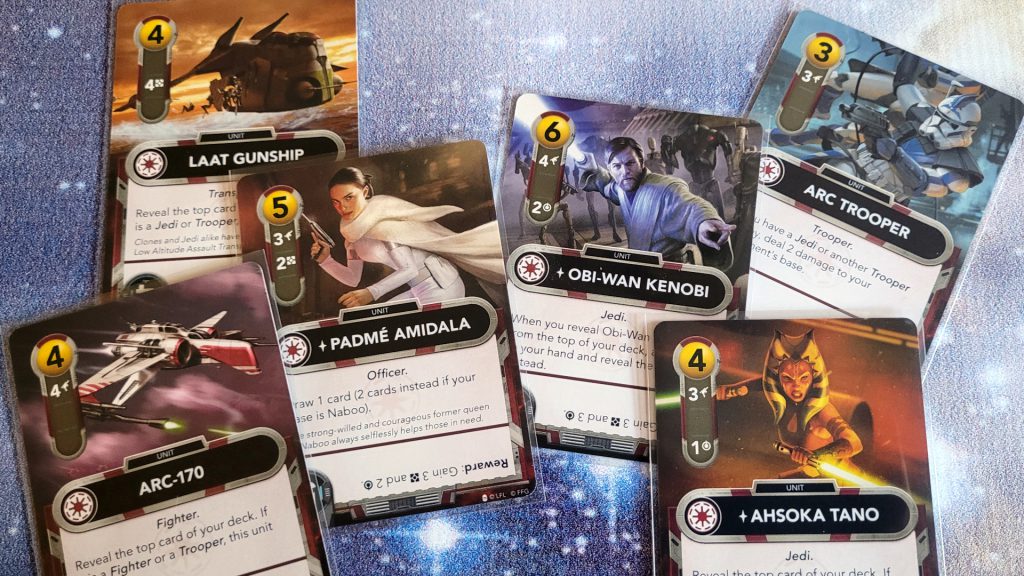
The neutral cards offer their own strategy, mainly revolving around playing a lot of neutral cards and manipulating the Galaxy row by making it easier to purchase and eliminate cards. And finally there’s Jar Jar Binks, who bounces between players moving the Balance of the Force marker and getting in everyone’s way.
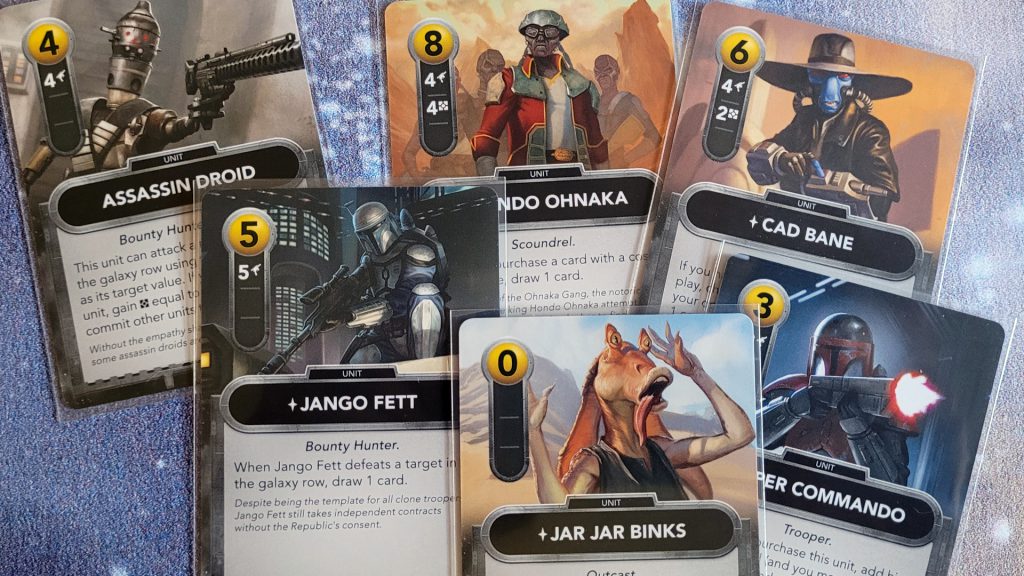
Faster. More Intense.
The game is on-theme and offers the players interesting and meaningful decisions, but the thing I like most about it is the fast pace. The turn structure is very simple and it avoids loaded keywords and other complicated game effects that can slow down a game and require frequent trips to the rulebook. Once you’ve played a few turns you’ll be cranking along, slamming cards down on the table to buy that awesome card from the galaxy row or knock out your opponent’s capital ship.
Of course that very simplicity makes for short games, and they can start to feel a little samey after a while. This is definitely not one you’re going to spend all afternoon on, but if you find that it’s difficult to carve out chunks of time for longer Star Wars games like Outer Rim or Star Wars Unlimited, then Star Wars: the Deckbuilding Game (either this one or the original trilogy version) might be a good alternative for you.
Have any questions or feedback? Drop us a note in the comments below or email us at contact@goonhammer.com. Want articles like this linked in your inbox every Monday morning? Sign up for our newsletter. And don’t forget that you can support us on Patreon for backer rewards like early video content, Administratum access, an ad-free experience on our website and more.
